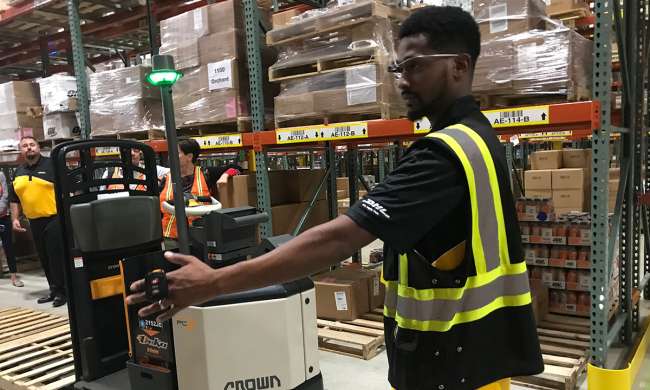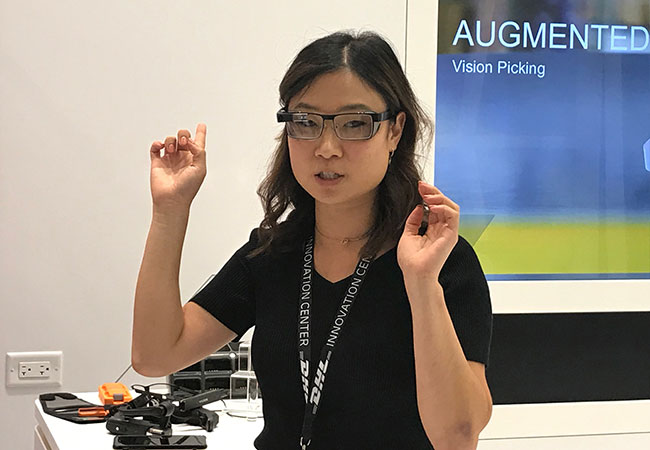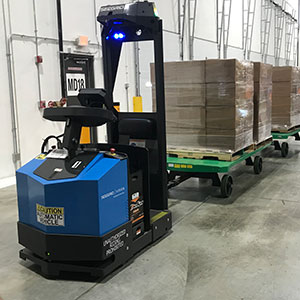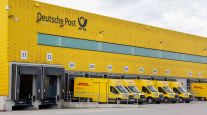Senior Reporter
DHL Opens Chicago Innovation Center

[Stay on top of transportation news: Get TTNews in your inbox.]
CHICAGO — Chicago’s long history as a transportation and logistics hub is one of the reasons DHL North America selected the city for its third Innovation Center worldwide.
The Americas Innovation Center, which opened Sept. 12, showcases technologies that already have provided significant productivity increases. This is especially so in peak volume times such as the holiday season, by using various robotic solutions, the company said.
Thanks for Sharing @SupplyChainDive! https://t.co/eJmexLunYy
— DHL U.S. (@DHLUS) September 12, 2019
Those solutions include automated guided vehicles that can ferry goods through warehouses, mobile robots that can facilitate order fulfillment in e-commerce operations and collaborative robots designed to help with repetitive tasks, such as picking and packing.
“We want to want to invest in technology, and it’s why we’re quite proud that as an organization globally this is our third innovation center, where we can display innovation we are working on … or testing new things we’re working on,” DHL Express CEO Mike Parra said.
Its other facilities are the DHL Innovation Center near Bonn, Germany, and the Asia Pacific Innovation Center in Singapore.
The Americas Innovation Center is near O’Hare International Airport, a major cargo hub where DHL has its largest North American warehouse at 470,000 square feet.
The Chicago facility is 28,000 square feet and employees, initially 15, will research technology including robotics, digitalization, virtual reality and artificial intelligence to improve the efficiency of the company’s transportation supply chain. They also will work with DHL’s hundreds of North American customers to improve their productivity.
“We actually tailor the experience to their industries,” said Gina Chung, head of Innovation for DHL Americas. “What are some of the key challenges to the technology sector, distribution, last mile? And all of the content has been developed for that specific customer.”

Gina Chung, head of innovation for DHL Americas, demonstrates Google Glass at the the company's new Americas Innovation Center. (Dan Ronan/Transport Topics)
The facility has different interactive stations focusing on visions, trends and innovation.
“We have a number of cutting-edge robotics solutions from our partners showcased here. We apply open innovation at DHL,” she said. “So all of our robotics partners are welcome to exhibit their solutions here and have real-time feedback from industry.”
DHL cited one example in which employees improved their productivity by nearly 20% when it came to learning how to process packages wearing Google Glass.
The warehouse, based in North Aurora, Ill., about 40 miles from the Innovation Center, is exclusively for sports and performance nutrition company Glanbia moving tens of thousands of pounds of food products each day through the facility. Much of the operation, from the stacking and moving of pallets to the cleaning of the warehouse, is automated. And company officials said it has been done without reducing jobs. Having many routine functions done by robots, frees up time for employees to focus on innovation.

The Tugger is one of the labor-saving robotic devices deployed in DHL's Americas Innovation Center in Chicago. (Dan Ronan/Transport Topics)
One SUV-size device, the “Tugger,” is a fully automated, vision-guided electric vehicle that follows a warehouse worker as that person loads pallets preparing to be shipped.
The Tugger is capable of carrying 10,000 pounds of freight, and DHL said it had improved the worker’s efficiency by 66% in terms of the speed of loading and unloading, and amount of items that can be processed.
A smaller device is the Vision Picking System. Using Google Glass, the worker is remotely operating a Crown Rider Double Pallet Jack. The machine understands voice commands and can move to the location it is needed to load and unload products in the warehouse.
Since the North Aurora facility contains food, it must be spotless. DHL soon plans to utilize robotic cleaning devices that can scrub the warehouse floor in about eight hours.
DHL is working with the robot’s manufacturer to modify the technology to include side scrubbers that will allow for the unit to clean closer to the stacked boxes, without using manual labor.
“A lot of these products are still in development. Since we’re such early adopters of the technology, it does require an agile approach to making it work,” said Mike Kreider, vice president of IT for DHL Americas.
DHL said its focus on technology improvements and innovation is driven by explosive growth in e-commerce as the company fights for market share in an increasingly competitive freight and logistics environment.
On Sept. 11, DHL Supply Chain announced new partnerships with Convoy and Turvo, in which the companies will integrate with DHL’s MySupplyChain, the company’s proprietary end-to-end visibility and business intelligence solution.
DHL Supply Chain is the first third-party logistics provider to partner with Convoy, a nationwide digital freight network that is focused on connecting the best trucking companies and shippers to move millions of truckloads.
“Convoy and DHL have a shared emphasis on moving freight more efficiently, and that focus forms the backbone of our relationship,” said Brooks McMahon, Convoy’s vice president of partnerships. “Now DHL can easily access Convoy’s automated real-time pricing and secure capacity that can flex with their customers’ needs.”



